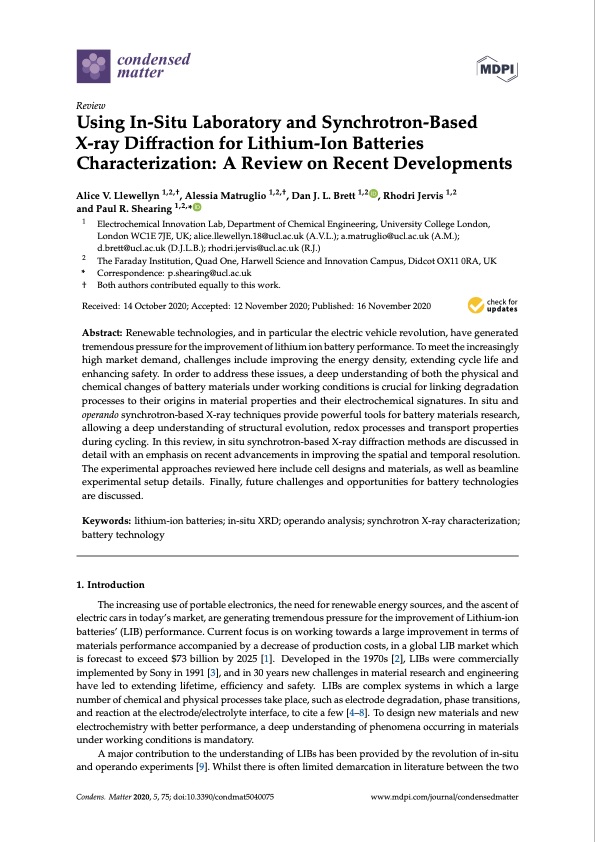
PDF Publication Title:
Text from PDF Page: 001
Review Using In-Situ Laboratory and Synchrotron-Based X-ray Diffraction for Lithium-Ion Batteries Characterization: A Review on Recent Developments Alice V. Llewellyn 1,2,†, Alessia Matruglio 1,2,†, Dan J. L. Brett 1,2 , Rhodri Jervis 1,2 and Paul R. Shearing 1,2,* 1 † Both authors contributed equally to this work. Received: 14 October 2020; Accepted: 12 November 2020; Published: 16 November 2020 Electrochemical Innovation Lab, Department of Chemical Engineering, University College London, London WC1E 7JE, UK; alice.llewellyn.18@ucl.ac.uk (A.V.L.); a.matruglio@ucl.ac.uk (A.M.); d.brett@ucl.ac.uk (D.J.L.B.); rhodri.jervis@ucl.ac.uk (R.J.) The Faraday Institution, Quad One, Harwell Science and Innovation Campus, Didcot OX11 0RA, UK 2 * Correspondence: p.shearing@ucl.ac.uk Abstract: Renewable technologies, and in particular the electric vehicle revolution, have generated tremendous pressure for the improvement of lithium ion battery performance. To meet the increasingly high market demand, challenges include improving the energy density, extending cycle life and enhancing safety. In order to address these issues, a deep understanding of both the physical and chemical changes of battery materials under working conditions is crucial for linking degradation processes to their origins in material properties and their electrochemical signatures. In situ and operando synchrotron-based X-ray techniques provide powerful tools for battery materials research, allowing a deep understanding of structural evolution, redox processes and transport properties during cycling. In this review, in situ synchrotron-based X-ray diffraction methods are discussed in detail with an emphasis on recent advancements in improving the spatial and temporal resolution. The experimental approaches reviewed here include cell designs and materials, as well as beamline experimental setup details. Finally, future challenges and opportunities for battery technologies are discussed. Keywords: lithium-ion batteries; in-situ XRD; operando analysis; synchrotron X-ray characterization; battery technology 1. Introduction The increasing use of portable electronics, the need for renewable energy sources, and the ascent of electric cars in today’s market, are generating tremendous pressure for the improvement of Lithium-ion batteries’ (LIB) performance. Current focus is on working towards a large improvement in terms of materials performance accompanied by a decrease of production costs, in a global LIB market which is forecast to exceed $73 billion by 2025 [1]. Developed in the 1970s [2], LIBs were commercially implemented by Sony in 1991 [3], and in 30 years new challenges in material research and engineering have led to extending lifetime, efficiency and safety. LIBs are complex systems in which a large number of chemical and physical processes take place, such as electrode degradation, phase transitions, and reaction at the electrode/electrolyte interface, to cite a few [4–8]. To design new materials and new electrochemistry with better performance, a deep understanding of phenomena occurring in materials under working conditions is mandatory. A major contribution to the understanding of LIBs has been provided by the revolution of in-situ and operando experiments [9]. Whilst there is often limited demarcation in literature between the two Condens. Matter 2020, 5, 75; doi:10.3390/condmat5040075 www.mdpi.com/journal/condensedmatterPDF Image | Synchrotron-Based X-ray Diffraction for Lithium-Ion Batteries

PDF Search Title:
Synchrotron-Based X-ray Diffraction for Lithium-Ion BatteriesOriginal File Name Searched:
condensedmatter-05-00075.pdfDIY PDF Search: Google It | Yahoo | Bing
Sulfur Deposition on Carbon Nanofibers using Supercritical CO2 Sulfur Deposition on Carbon Nanofibers using Supercritical CO2. Gamma sulfur also known as mother of pearl sulfur and nacreous sulfur... More Info
CO2 Organic Rankine Cycle Experimenter Platform The supercritical CO2 phase change system is both a heat pump and organic rankine cycle which can be used for those purposes and as a supercritical extractor for advanced subcritical and supercritical extraction technology. Uses include producing nanoparticles, precious metal CO2 extraction, lithium battery recycling, and other applications... More Info
| CONTACT TEL: 608-238-6001 Email: greg@infinityturbine.com | RSS | AMP |